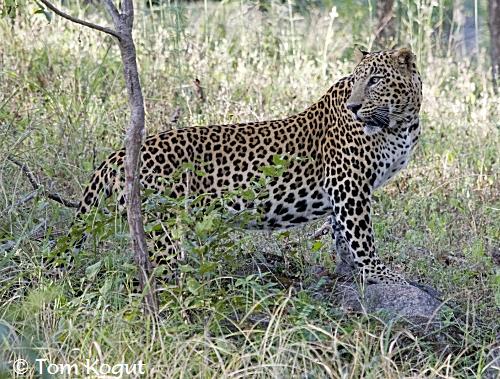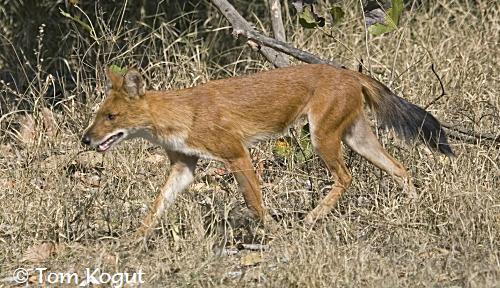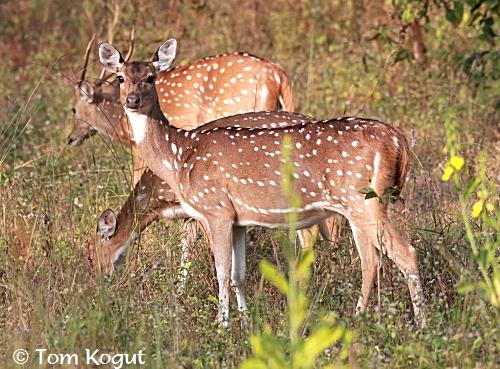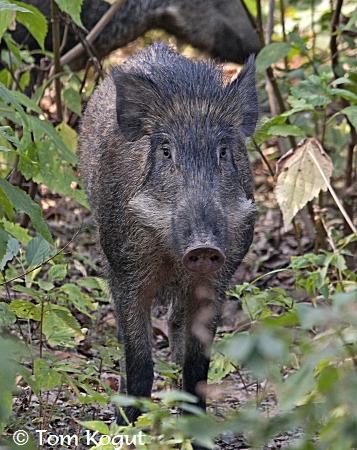|
Explanation: This
week we are in Kanha National Park in the central Indian state of Madhya
Pradesh. Kanha is one of the best places in the world to observe tigers in the
wild, and attracts large numbers of tourists eager to glimpse this iconic
predator.
In addition to tigers, Kanha boasts healthy populations
of two other large predators: leopard and dhole, or Indian wild dog. Both of
these species prey on some of the same species as the tiger.

Leopard (Pantera
pardus) above,
and dhole (or Indian wild dog, Cuon alpinus)
below,
occur in the same areas, but avoid competition by
utilizing completely different hunting strategies.

The superb jungle and meadow habitats of Kanha produce
large populations of deer (four species occur), wild boar, and other animals
which provide a dependable, year-round food supply for these three carnivores.
But how can all three large predators occur in one place
without competing directly with each other to the point of mutual exclusion?
The key is resource partitioning, which is the division
of resources in an ecosystem by the species who need them, each using them in
a different way. Tigers and leopards are stealth predators who spot prey and
then stalk close enough to pounce. Tigers are much larger than leopards
however, and therefore can take down very large prey including the massive
gaur, or Indian bison, which can weigh over a ton!
Leopards are opportunistic and highly adaptable
predators that prey on a much wider variety of species than do tigers, and
generally avoid hunting in territories occupied by their larger relatives
which often kill wayward leopards. Almost any small or medium-sized animal is
fair game to leopards, which are the most numerous and widespread large
predator in India.

Chital, or spotted deer (Axis axis) are the most common deer
species
over most of India, and give a loud, high-pitched alarm call
when they smell or sight predators like tigers, leopards, and dhole.
Dholes utilize an entirely different hunting strategy
than do tigers and leopards. They hunt in packs typically numbering 3-12
individuals, although occasional packs of 40 have been reported. They are
constantly on the move and once a prey species- usually medium-sized deer such
as chital or spotted deer - are isolated and surrounded, there is little hope
of escape. Dhole packs are fearless and occasionally even attack and kill
tigers- certainly a predator to be avoided at all costs!

Wild boar (Sus scrofa) are very
wary and social animals that appear regularly on the menu of all three large
predators.
So by separating their main types of prey, and by using
different hunting strategies, tigers, leopards, and dholes can coexist. Such
effective stable resource partitioning is the result of past competition -
sometimes referred to as the "ghost of competition past."
However, even in protected areas like Kanha National
Park, all three predators face numerous threats including poaching, poisoning
and vehicle collisions. Analyses suggest that, should their populations become
unstable from such threats, then the ghost of competition will rise again and
likely force one or more species into local extinction.
The future of all three is far from certain, and only
diligent conservation efforts will ensure that the jungles of Kanha and other
areas continue to be fully functional ecosystems that inspire awe, fear and
wonder.
Information:
Breeden, Stanley and Belinda Wright. 1996. Through the
Tiger's Eyes: A Chronicle of India's Wildlife. Ten Speed Press, Berkeley,
California. 194 pp.
Menon, Vivek. 2003. A Field Guide to Indian Mammals. Dorling
Kindersley (India) Pvt. Ltd. 201 pp.
Schmidt, K. A., J. M. Earnhardt, J. S. Brown, and R. D. Holt.
2000. Habitat selection under temporal heterogeneity: exorcizing the Ghost of
Competition Past. Ecology 81(9):2622-2630.
Thapar, Valmik. 2004. Tiger: The Ultimate Guide. CDS Books, New
York, N.Y. 340 pp.
|
Index |
Location | Search | About EPOW | ... Next >